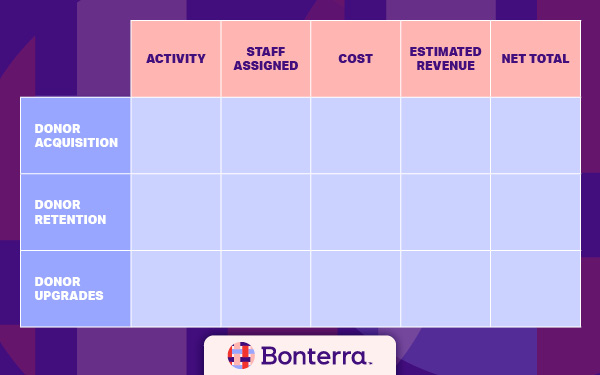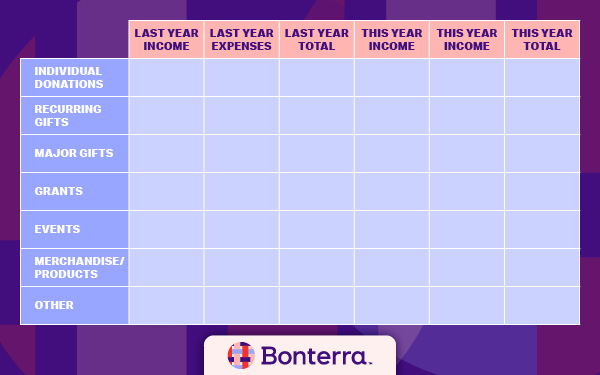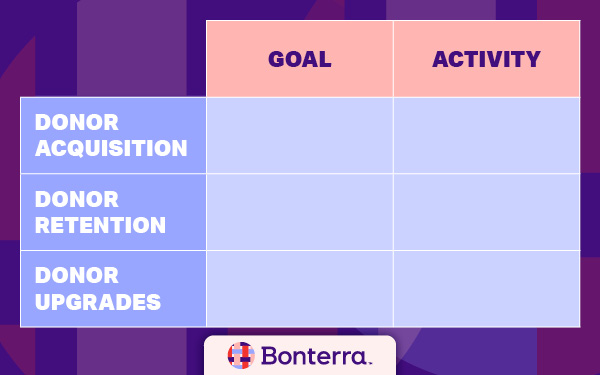Crash course: your 7 step nonprofit fundraising plan

What’s the number one predictor of fundraising success? It all comes down to creating a nonprofit fundraising plan. Just by taking the time to reflect on your goals and put a plan into writing, your nonprofit organization will be in a better position to meet its fundraising objectives.
In this article, we’ll explore the seven steps nonprofits can take to build a successful fundraising plan. Then, we’ll get you started crafting your own fundraising plan with a few free templates.
- Step 1: Reflect on last year’s fundraising plan.
- Step 2: Identify existing resources.
- Step 3: List activities to attract, renew, and upgrade donors.
- Step 4: Create goals for each fundraising plan activity.
- Step 5: Identify fundraising plan focus areas.
- Step 6: Put your fundraising plan on the calendar.
- Step 7: Set yourself up for success.
- Sample fundraising plan templates
While the exact details of every nonprofit’s fundraising plans will be different, this crash course will explore strategies that can apply to almost every situation. Let’s get started.
Step 1: Reflect on last year’s fundraising plan
If you had a fundraising plan last year, begin by assessing how well you followed it. Gather data from a fundraising software like Network for Good and other available sources, such as donor feedback surveys, past budgets, or interviews with staff members.
By analyzing your past fundraising plan, you can identify where you succeeded and what you can improve on. When looking at your data, ask yourself these questions:
- How much did you raise last year? List your fundraising activities and their financial outcomes.
- What were your biggest successes? Look at where you made an impact and the accomplishments you’re proud of.
- What were your biggest challenges? Reflect on what didn’t go as planned or where you want to focus more attention, time, or resources. This could be specific improvements to ongoing initiatives, like meeting with prospective major donors more frequently, or entirely new goals, such as launching a recurring giving program.
After discussing these results with your team, work together to build on your old strategies and create targeted goals for this year.
Step 2: Identify existing resources
What resources do you have now that can help your fundraising? Be realistic in terms of availability and limitations. Most organizations start this process by taking a look at their:
- Budget. How much does your nonprofit have to spend on fundraising? Are there restrictions you have to consider, such as grant stipulations, bequest requirements, or donations given to specific campaigns?
- Staff. Consider your staff’s time and expertise when planning your fundraising strategy. If you want to launch a new fundraising program, do you have the staff on hand to run it? Will you need to recruit volunteers or invest in training opportunities?
- Technology. What technology does your nonprofit currently have? Are you in need of an upgrade? Assess if your current platforms are still scaling with your efforts or if it’s time to invest in a new software solution.
By taking inventory of your current resources, you’ll be able to build a fundraising plan based on tangible assets and constraints. This will make your goals more realistic and ensure you leverage all of your resources to maximum effect.
Step 3: List activities to attract, renew, and upgrade donors
Make a list of activities that will help grow your individual giving programs. Think about activities that will help with:
- Donor acquisition. To expand, your nonprofit organization needs to recruit new donors. Try launching a new marketing strategy, expanding to different marketing channels, hosting a peer-to-peer campaign, partnering with other organizations, or hosting events that are open to your local community.
- Donor retention. Stewarding your existing donors will create lasting, consistent support for your organization. Work to retain your donors by personalizing communications, collecting and implementing donor feedback, and suggesting options to make recurring giving easy.
- Upgrading current donors. Each of your donors will increase in value over time if you ask them to consider increasing their donation amount. Encourage donors to upgrade by creating a membership program, starting a planned giving program, conducting prospect research, and generally improving the donor experience.
While you may focus more heavily on one of these aspects to align with your current goals, ensure you account for all three in your fundraising plan. After all, new donors are far more worthwhile if you retain them, and retained donors are at their most valuable when you take steps to upgrade them.
Step 4: Create goals for each fundraising plan activity
After evaluating your nonprofit‘s current fundraising priorities, it’s time to establish solid goals. Here are a few components to consider when setting new goals:
- Dollars raised: What is your annual fundraising total? Base this year’s goal on your total raised last year.
- New donors: How many total donors do you have? Compared to last year, how many do you think you can realistically attain this year?
- Recurring gifts: Has your nonprofit developed a recurring gift program? What can you do to enroll more donors in it?
- Board participation: How much has your board contributed to hitting your donation and supporter acquisition goals? What can you do to encourage them to get more involved?
This process gets your entire organization on the same page about your priorities and ensures everyone understands the impact achieving your goals will have.
Step 5: Identify fundraising plan focus areas
After establishing your goals, determine what specific actions you can take to accomplish them. When implementing any new activity or program, consider how it fits into your overarching strategy.
For example, if you want to recruit new donors, you may decide to expand your online outreach. This goal can be broken down even further into specific online activities. You might focus on launching a peer-to-peer campaign or participating in #GivingTuesday. If you’re just getting started in online giving, making your donation pages mobile-friendly and branded should definitely top your list.
Step 6: Put your fundraising plan on the calendar
A fundraising plan feels a lot more doable when you map out the work over time. Set deadlines and think of them as milestones where you can gauge your success. Use whatever tool works best for you: paper calendars, Excel spreadsheets, or an online tool.
Start with existing commitments—events, board meetings, grant deadlines, staff vacations—and put them in the calendar. Knowing you want to get something done that you can share at the July board meeting can be a great motivator. Or, if you see that the end of April is especially busy, you’ll be able to balance your schedule ahead of time.
Write in your monthly and seasonal focus areas. Maybe March is when you target new monthly donors, and fall is busy with #GivingTuesday and year-end planning. While this calendar may change as new challenges and opportunities arise, having a roadmap will keep you on track all year long.
Step 7: Set yourself up for success
Identify what helped you succeed in the past. By reviewing last year’s fundraising plan, you should understand what strategies work best for your nonprofit. Combined with new goals, these proven strategies will appeal to your supporters, help keep your team motivated, and ensure your resources are being used wisely.
Here are a few strategies nonprofits often implement to ensure they stay on track and fulfill their fundraising plan:
- Create an accountability system. To ensure everyone follows through with their tasks, determine how you will assign specific projects and check in on them. For example, you may partner up team members or use your project management tool to assign each task to a specific person.
- Block out time for high priority tasks. Determine your highest priority tasks and set aside time to see them through to completion. Consider dedicating a specific time to calling donors and checking in with major giving prospects.
- Hold regular team check-ins. Meeting with staff will provide opportunities to ensure everyone is on track, share information, and make plans to unblock anyone who may be stuck on a project.
When your team does succeed, make sure to let them know and celebrate. If your team falls short, take the time to assess what could have been done better and make a concrete plan for how you’ll approach that goal in the future.
Sample fundraising plan templates
To help your nonprofit develop a new fundraising plan, here are a few free templates:



Use the template that best aligns with your organization’s needs and goals, or experiment with using all three. Remember to reevaluate your fundraising plan throughout the process to make the adjustments you need to succeed.
Ready to Get Started?
Work with Bonterra



